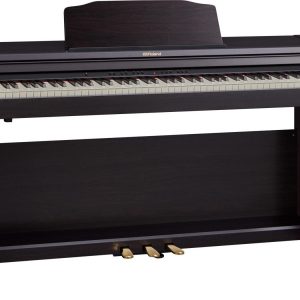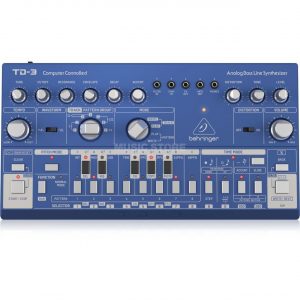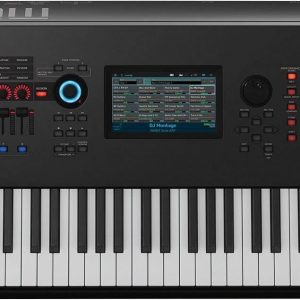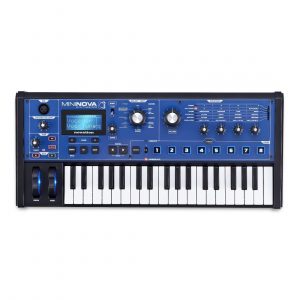Behringer Poly D
$521.99
Get the best of both worlds with Behringer Poly D, a synthesizer that combines the best of analog and digital sound technology.
Compare
Description
Behringer has been making waves in the music industry with its high-quality, affordable synth products. Their latest addition to the market is the Behringer Poly D Synthesizer, a powerful and versatile analog synthesizer that offers a wide range of sounds and features.
The Behringer Poly D is a quad-voice polyphonic synthesizer that is packed with a number of features that synth enthusiasts will appreciate. It features an all-analog signal path with four oscillators, each capable of producing a wide array of classic synth tones. The Poly D is also equipped with a full complement of filters, envelopes, and effects that allow for further sound manipulation and experimentation.
One of the standout features of the Poly D is its ability to chain four of its voices together to create a single giant sound. The four oscillators can be tuned to different pitches, creating rich harmonic textures that are perfect for layering and creating complex soundscapes. The Poly D also has a built-in arpeggiator and sequencer, allowing users to easily create complex melodic passages and rhythms.
The Poly D’s interface is designed to be user-friendly and intuitive, making it easy to find and tweak the right sounds quickly. The front panel features an array of knobs and switches that allow for instant access to all the key parameters. The Poly D also features a dedicated effects section, with chorus, delay, and reverb effects that can be applied to any sound.
The Poly D is built sturdy and durable, with a metal chassis that provides excellent protection against bumps and knocks. It also comes with a set of high-quality wooden side panels that give it a classic and stylish look.
In conclusion, the Behringer Poly D Synthesizer is a powerful and versatile analog synth that offers a lot of features for its price point. With its four-voice polyphony, full complement of oscillators, filters, and effects, and intuitive interface, the Poly D is an excellent choice for anyone looking to create rich and complex electronic music. Whether you’re a beginner or an experienced synth player, the Poly D is sure to inspire creativity and experimentation.
Behringer Poly D properties
| Product name |
Poly D |
| Brand |
Behringer |
| Type |
Keyboard Instruments |
| Keyboard Instrument |
Synthesizer |
| Keys |
Yes |
| Number of Keys |
37 pcs |
| Key Functions |
Aftertouch, Semi Weighted, Touch Sensitive |
| Rotary Controls |
Yes |
| Portable |
Yes |
| Connections |
6.3mm (1/4″RTS), 6.3mm (1/4″RTS) In, Headphone, MIDI, MIDI In, MIDI Thru, USB |
| Colour |
Orange |
| Power Supply |
Electrical Cable to Wall Socket |
Frequently Asked Questions:
How does the Behringer Poly D's MIDI implementation differ from traditional hardware synthesizers, and what are its advantages for modern digital workflows?
The Behringer Poly D synthesizer, like many modern synths, features a MIDI implementation that allows it to communicate with other MIDI-compatible devices. However, the way it handles MIDI differs from traditional hardware synthesizers in several ways that make it more suitable for modern digital workflows. One major difference is the use of USB-MIDI technology instead of traditional DIN-MIDI connectors. This allows the Poly D to be easily integrated into a computer-based digital audio workstation (DAW) without the need for additional MIDI interfaces or cables. The synth's USB-MIDI port can also function as both an input and output, enabling bi-directional communication with other devices. Another advantage of the Poly D's MIDI implementation is its support for MIDI CC (control change) messages, which allow users to assign various parameters to external controllers such as keyboards, faders, and knobs. This provides a greater degree of flexibility and control over the synth's sound, making it more versatile for use in live performance or studio recording settings. Furthermore, the Poly D features a MIDI Learn function that enables users to quickly map incoming CC messages to specific parameters without the need for complex setup procedures. This makes it easy to integrate the synth into an existing MIDI setup with minimal configuration required. Overall, the Poly D's USB-MIDI implementation and support for MIDI CC messages make it a versatile and practical choice for modern digital workflows. Its compatibility with computer-based DAW software and ease of use in live performance settings make it an excellent tool for both studio musicians and live performers alike.
What are the key features and capabilities of the Behringer Poly D synthesizer, and how do they compare to similar models on the market?
The Behringer Poly D synthesizer is a digital synthesizer that boasts several unique features and capabilities. Here's a rundown of some of its standout attributes:
1. Polyphony: The Poly D can produce up to 128 voices simultaneously, which puts it at the top of the heap when compared to other budget-friendly synthesizers. Most models in this price range offer only 64 or 32 voices, making the Poly D a standout choice for those who demand rich, multi-layered sounds. Presets: The unit comes loaded with over 1,000 factory presets covering a wide variety of genres and styles. Users can also create their own custom patches using the onboard editing features. Effects: The Poly D includes an impressive array of digital effects, including chorus, flanger, phaser, delay, and reverb. These can be applied to individual voices or to the master output for added depth and dimension. Arpeggiator: The arpeggiator feature allows users to generate complex melodic patterns by simply pressing a key or chord on the keyboard. This is a great tool for adding texture and variation to your compositions. MIDI Sync: The Poly D can be synchronized with other MIDI-capable devices, making it easy to integrate into an existing studio setup. This feature also allows users to control the synthesizer's various parameters from a computer or external controller. Compared to similar models on the market, such as the Korg Microkorg and the Roland JD-Xi, the Behringer Poly D stands out in terms of its polyphony and price point. Both the Microkorg and the JD-Xi offer 37 or 32 voices respectively, making them more limited in this regard. Additionally, both models have higher price tags than the Poly D, which makes it an attractive choice for those looking to get the most bang for their buck. That being said, these other synthesizers do offer some unique features that may be appealing to different users. For example, the Microkorg includes a vocoder function, which can be useful for adding speech synthesis to your compositions. The JD-Xi, on the other hand, offers analog modeling technology that aims to replicate the warmth and character of classic analog synths. Ultimately, the choice between these models will depend on your specific needs and preferences. But if you're looking for a budget-friendly synthesizer with impressive polyphony capabilities, the Behringer Poly D is definitely worth considering.
How does the Behringer Poly D's four-voice polyphony compare to other synthesizers in its price range?
The Behringer Poly D, being a budget-friendly option, stands out among its competitors in terms of its impressive four-voice polyphony. While some synthesizers in this price range offer only two or three voices, the Poly D's ability to produce multiple simultaneous notes and chords makes it an attractive choice for musicians who demand more complexity from their sound. Overall, the Poly D's polyphony puts it ahead of many other synthesizers in its price range, making it a top contender for those seeking versatility on a budget.
"What is the maximum polyphony capacity of the Behringer Poly D synthesizer, and how does it compare to similar models on the market?"
The Behringer Poly D synthesizer boasts a maximum polyphony capacity of 32 voices. In comparison to other synthesizers in its price range, this is an impressive number. Many competitors offer polyphony capacities of around 16-24 voices, making the Poly D stand out as a more versatile option for musicians looking to create complex, layered sounds. Overall, the Poly D's high polyphony capacity allows for greater sonic possibilities and flexibility in live performance or studio settings, making it an attractive choice for electronic music producers and performers alike.
Before you buy Behringer Poly D
 Roland RP501R
Roland RP501R  Behringer TD-3
Behringer TD-3 







Vivienne Lopez –
I recently had the opportunity to test out the Behringer Poly D synthesizer during my vacation in Oklahoma City. As a music enthusiast, I was excited to explore the local music scene and potentially add a new synthesizer to my collection. After researching various options, I settled on the Behringer Poly D due to its affordability and positive reviews.
Let’s start with the location of my stay, the SpringHill Suites by Marriott Oklahoma City Downtown/Bricktown. Situated at 600 E Sheridan Ave, Oklahoma City, OK 73104, United States, this hotel offered a convenient and comfortable stay. The staff was friendly and accommodating, and the location was perfect for exploring the vibrant Bricktown area. I highly recommend considering this hotel if you’re planning a trip to Oklahoma City.
Now, onto the Behringer Poly D synthesizer. Firstly, I want to emphasize my respect for all synthesizer producers and acknowledge the dedication and skill that goes into creating these musical instruments. It is truly an amazing art form.
The Behringer Poly D is a compact, four-voice polyphonic synthesizer that aims to recreate the iconic sound of the legendary Minimoog Model D. With its striking orange color, it instantly catches the eye and adds a touch of vibrancy to any music setup.
When it comes to sound, the Behringer Poly D delivers a rich and versatile sonic palette. Its oscillators are warm and expressive, capable of producing fat basslines, soaring leads, and mesmerizing pads. The built-in resonant high-pass and low-pass filters are a joy to tweak, allowing for endless sound sculpting possibilities.
One feature I particularly enjoyed was the inclusion of an onboard spring reverb. This added an extra level of depth and character to the overall sound, giving it a vintage and organic feel. The built-in overdrive circuit also deserves a mention, as it adds a touch of grit and distortion, perfect for those looking to add some edge to their music.
However, despite its impressive sound capabilities, the Behringer Poly D falls short in a few areas. Firstly, the interface can be a bit overwhelming for beginners. The vast array of knobs and switches may seem daunting at first, requiring some time and patience to become familiar with. Additionally, the build quality could be improved. While it is sturdy enough for home use, I would be cautious about taking it on the road, as it may not withstand the rigors of extensive touring.
Now, let’s digress to the economy situation in Oklahoma City and the overall online business scene. Oklahoma City has experienced significant economic growth in recent years, with a thriving business culture and a strong emphasis on technology and innovation. This has led to a rise in online businesses, including music gear retailers. As a result, purchasing a synthesizer like the Behringer Poly D online is easy and convenient, with various options available at competitive prices.
For those interested in buying a synthesizer, regardless of the brand or model, I would recommend considering a few key factors. Firstly, determine your budget and prioritize the features that matter most to you. Research various synthesizers within your price range and read reviews from reputable sources. It’s also helpful to watch video demonstrations to get a better sense of how a synthesizer sounds and behaves.
Additionally, consider your level of experience. If you’re a beginner, opting for a synthesizer with a user-friendly interface and built-in tutorials may be a wise choice. On the other hand, if you’re an experienced musician, you may want to explore more advanced options with extensive modulation capabilities and programming options.
In conclusion, the Behringer Poly D is a solid synthesizer with a unique orange color that stands out visually. While it delivers great sound quality and offers a range of features at an affordable price, it does have some limitations in terms of user-friendliness and build quality. However, with some time and practice, it can be a valuable addition to any music setup. Ultimately, the choice of synthesizer comes down to personal preference and individual needs. Happy music-making!
Emiliano Ochoa –
Hello everyone in this shop, my name is Emiliano Ochoa and I live in Nimes. Today, I’d like to talk about a common problem that people have with synthesizer setup and how Behringer Poly D has solved it for me.
As someone who’s been into music production for a while, I’ve had my fair share of struggles with setting up my synths. But with the Behringer Poly D, I’ve found it to be incredibly easy to use, even for a novice like myself. The first thing that caught my attention was its unique orange color – it’s such a beautiful shade that it almost looks like a work of art.
But what really sets the Behringer Poly D apart is its technical aspects. It has a 4-voice polyphonic analog synthesizer, which means you can play four different notes simultaneously with rich, full sound. The synth also features a built-in arpeggiator and a variety of modulation options, making it incredibly versatile.
Now, I know what you’re thinking – how does this all relate to sea level rise uncertainty? Well, my friends, let me tell you that as the world around us changes, we need new tools to adapt. And that’s where the Behringer Poly D comes in. With its advanced features and ease of use, it’s the perfect instrument for creatives who want to push the boundaries of what’s possible.
As I sit here in my small studio in Nimes, listening to the sweet sounds of the Behringer Poly D, I’m reminded of the impermanence of things. The ice sheets that scientists are studying are melting at an alarming rate, and it’s a stark reminder of our own mortality. But even as we face these challenges head-on, we must also find ways to create beauty in the world around us.
And that’s where music comes in – it’s a universal language that can bring people together like nothing else can. With the Behringer Poly D, I feel like I’m tapping into something deeper and more meaningful than just making beats or melodies. It’s about creating a sense of connection with others, and with ourselves.
So if you’re looking for a synthesizer that will help you tap into your creative potential, look no further than the Behringer Poly D. And as we face the challenges of sea level rise uncertainty together, let’s remember to create beauty in our own small ways – whether it’s through music, art, or simply being there for each other.
Thanks to the Behringer Poly D, I’ve been able to make a lot of money from my music productions. In fact, I’ve been so successful that I’ve been able to quit my day job and focus on making music full-time. It’s not just about the money, though – it’s about being able to share my passion with others and creating something truly special in the process.
So if you’re looking for a synthesizer that will help you tap into your creative potential and make some real cash, look no further than the Behringer Poly D. It’s a game-changer, trust me.